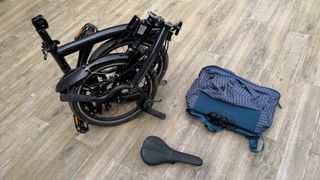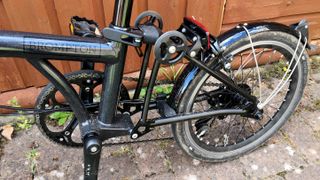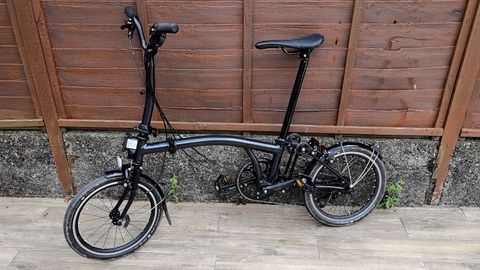TechRadar Verdict
The Brompton P-Line makes a very sensible choice if you’re after a bike for commuting. It’s lost weight, but still boasts the same ingenious folding design that makes it ideal for carrying onto a train, bus, or storing in the boot of your car for spontaneous two-wheeled forays. However, it’s still not the sort of bike you’d want to go too far on: the wheels are small, four-speed gearing is limited, and the saddle offers workmanlike support. The Brompton P-Line is well-suited for around-town use, but it’s up against many rivals that do much the same thing and often for less money.
Pros
- +
Lighter design
- +
Clever folding mechanism
- +
Decent gearing
Cons
- -
Folding mechanism baffling for some
- -
Not the cheapest option
- -
Caliper brakes
Why you can trust TechRadar
Two-minute review
Anyone who hankers after a Brompton will love the lighter, leaner P-Line, which at just 9.65kg is something that can be carried with relative ease when needed. Unfolded, the bike delivers an unsurprising ride, which is compromised a little by small wheels and tyres, plus a saddle that’s not made for hours of sitting on.
There are four gears, controlled by a handlebar shifter and decent caliper-style brakes. Folded, the Brompton P-Line can be hidden out of harm’s way in all sorts of locations from train baggage holds to car trunks, or even a cupboard under the stairs. Brompton bikes are expensive though and if you’re not worried about a little more weight you’d do just as well to head in the direction of the standard-issue models in the Brompton range.
The Brompton P-Line is a lighter version of its classic folding bike, which the British manufacturer has been tweaking and fine-tuning over the 45 or so years it’s been in production. You get the usual quirky design lines and an expensive price tag, but with the bonus of being able to ride on down the road with a little less weight to lug around.
In fact, there are nearly two kilos shaved off the overall weight compared to a standard Brompton C-Line model, thanks to lighter components and some engineering tweaks. All told, the Brompton P-Line weighs in at 9.65kg, which gets it off to a great start.
Price and release date
The Brompton P-Line Urban is available now and costs from £2,264 in the UK ($2793 approx. in the US). However, there is also the Brompton P-Line Urban with Roller Frame, which costs from £2,344 ($2,892 approx. in the US), but adds on larger trolley-style wheels for easier rolling of the bike when required.
Brompton also does a nice line in numerous cycling accessories, created specifically for the range, all of which can be specced for additional cost.

Design
Brompton is quick to underline the appeal of the newer P-Line (as in P for Performance) model, mainly because of its weight loss, which is 1.85kg less than the regular edition of this folding classic. That doesn’t sound like a lot, but you do notice it if you have the carry the bike any kind of distance. Some 700g of weight alone has been shaved off by replacing the steel-framed original with a titanium rear frame section and forks, along with a plethora of weight-loss tweaks to other components.
To look at, however, this is classic Brompton and the folding mechanism is just as it is on other bikes in the range. Now, it seems you’ve either got the knack for unfolding and folding a Brompton bike, or you haven’t. I’ve always found them awkward, especially when compared to other folding bikes, like the Axon Pro Lite or the chunkier but really good GoCycle G4 we looked at recently, for example. There’s no denying Brompton has created a very clever design, but I’m still not sure it’s as intuitive as they make out. Maybe it’s just me.
The Brompton P-Line proved no different, with a good degree of faff involved to get it up. Two people, a YouTube video plus an oily chain coming off were all part of the procedure. The saddle also proved problematical to get on. Maybe it wasn’t helped by this being a ‘refreshed’ bike that had been reviewed elsewhere. Perhaps this was the same reason there was no toolkit present, or much else for that matter. But after about 30 minutes the Brompton P-Line came together, looking quite good in the metallic black too.
The great thing about the design is the way it integrates a four-speed derailleur gear set, which proves even more useful as you can hinge the lower arm upwards and thread a chain back on easily enough. The changing mechanism on the left-hand side of the handlebars is fine and functional. There are also the two little wheels on the back of the bike which allow you to wheel it along half-folded when and if you have to. A suspension block in the frame design offers a little relief if you get caught out by an unexpected rut in the road.
In addition, there’s a bracket on the front of the bike for a carry bag attachment, an example of which was included in the box with our model. Traditional 16-inch wheels with Schwalbe tires and standard caliper/rim brakes round things out in old-school cycling style. We also appreciated the full mudguards too, which soon become an essential part of the package if you’re commuting to work in the wet and want to minimize dirt and mud flecks on your suit.
This bike came with reflectors, but no lights as standard. We’d also like to see a kickstand, even if it’s only a flimsy plastic effort just for the sake of convenience. You'll have to factor the lights into your budget, especially if you're buying for commuting home in the dark.

Performance
Heading off down the road on the Brompton P-Line and the experience feels much like the cheaper counterparts in the product portfolio. If you’re lucky enough to have access to smooth purpose-built cycle lanes the bike is great on the flat, even with those dinky little wheels. There is, of course, that slightly weird feeling of holding on to handlebars that you know you’ve folded up earlier, but the reassurance that the solid bracket isn’t going to fail you. Hit less than great British road surfaces though and it all feels a little more precarious.
That’s nothing to do with the Brompton P-Line, as it does contend with less smooth surfaces surprisingly well. You’ll want to lift your behind off the saddle over dreaded potholes or zipping up over low kerbs, but that’s par for the course with any cycling experience in the UK.
Meanwhile, putting the Brompton P-Line through its paces in hilly areas requires deft use of the gears though as, despite the lighter weight, this is a bike that isn’t great for too many steep inclines. Coming down the other side is lots of fun however, and those brakes work well enough, but do lack the more refined muscle of discs and rotors.
We tried the Brompton P-Line on a variety of surfaces too, including gravel paths, where it performed well enough. The narrow tyres can catch you out if you’re not careful though, but this is a bike that’s designed with city streets in mind anyway. Nevertheless, it’s good to know the Brompton can assist you with any cross-country shortcuts, if you’re very late for a meeting at the office.
Quite how many P-Line models will end up being used as genuine commuter bikes remains to be seen, given the trend for home and hybrid working. Good as it is, this is an expensive bike to buy for casual use.
Buy it if:
- You’re still commuting. The Brompton P-Line is tailor-made for the task, but comes with a high price tag.
- Space is at a premium. Storing this bike is quick easy and it’ll fit almost anywhere, especially compared to standard cycles.
- You’ve always dreamt of owning a Brompton. The design is iconic and, if you can master its folding charms you’ll love the thing.
Don't buy it if:
- Small wheels are a turn-off. There are compromises to be had with the P-Line, so it’s less great for longer journeys.
- You’ve given up on the commute. Even hybrid working, with perhaps 3 days a week in the office, will make this Brompton hard to justify.
- You’d like a cheaper alternative. Buy the standard Brompton instead, especially if your budget is limited.
First reviewed: May 2022
Rob Clymo has been a tech journalist for more years than he can actually remember, having started out in the wacky world of print magazines before discovering the power of the internet. Since he's been all-digital he has run the Innovation channel during a few years at Microsoft as well as turning out regular news, reviews, features and other content for the likes of TechRadar, TechRadar Pro, Tom's Guide, Fit&Well, Gizmodo, Shortlist, Automotive Interiors World, Automotive Testing Technology International, Future of Transportation and Electric & Hybrid Vehicle Technology International. In the rare moments he's not working he's usually out and about on one of numerous e-bikes in his collection.
Most Popular




